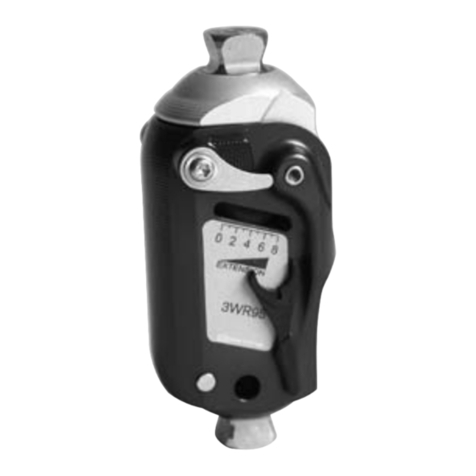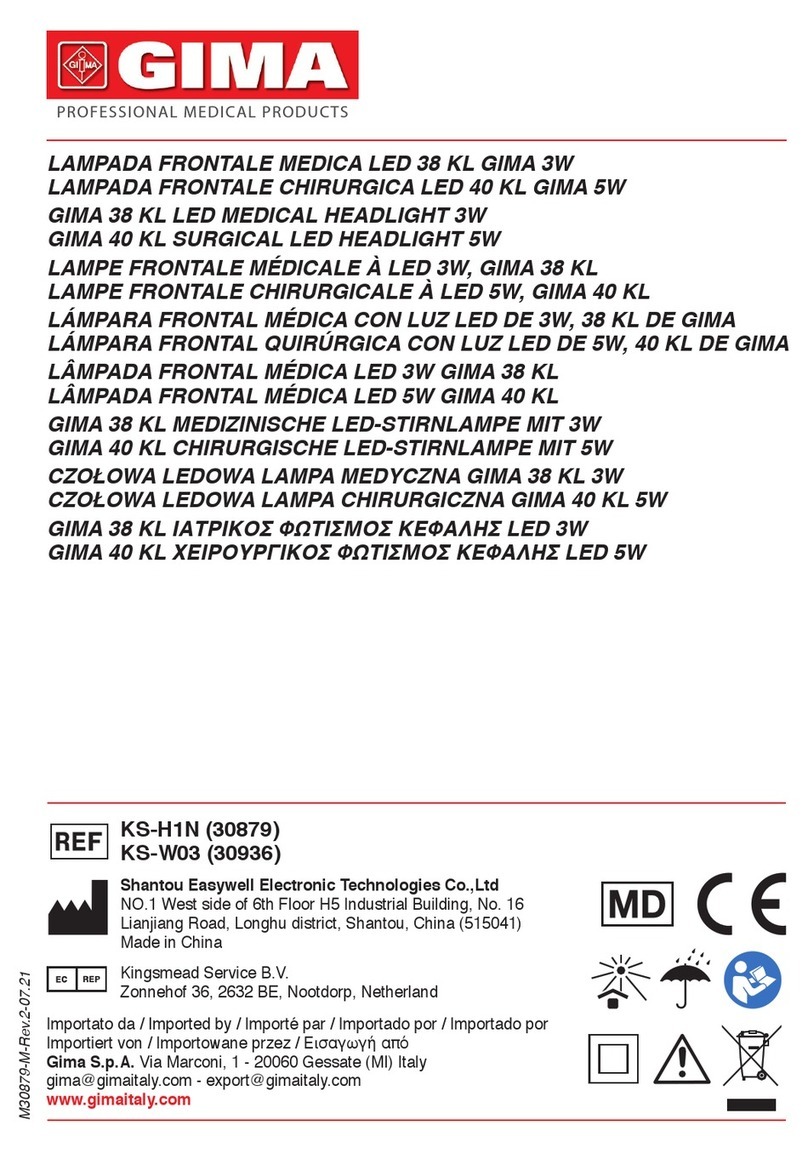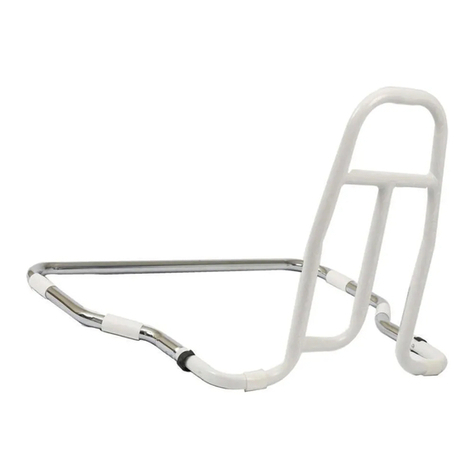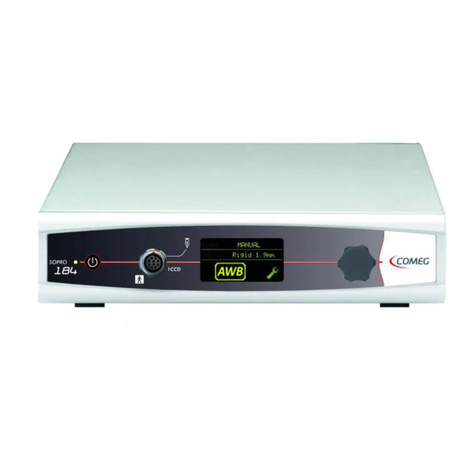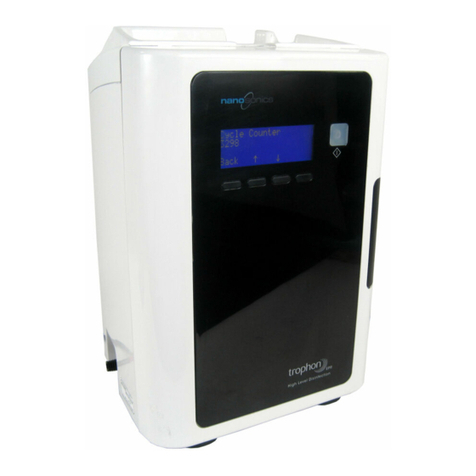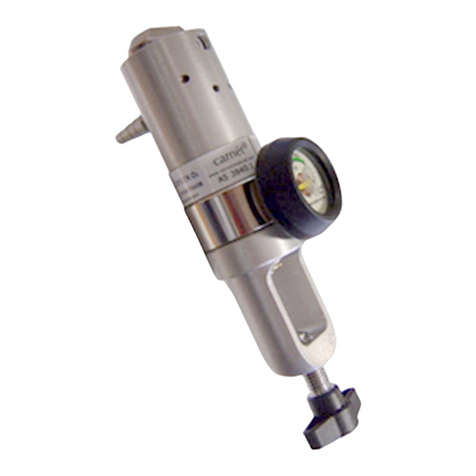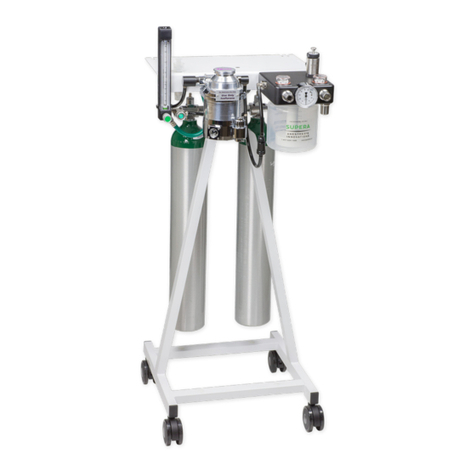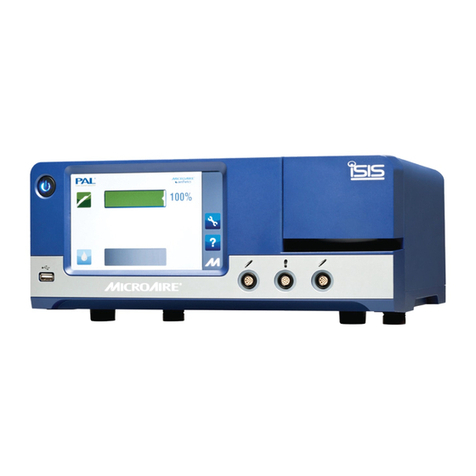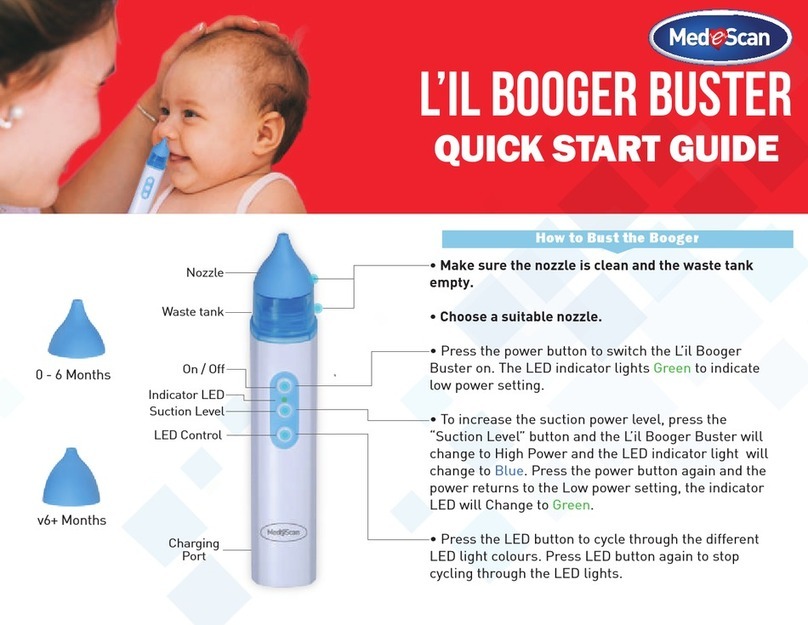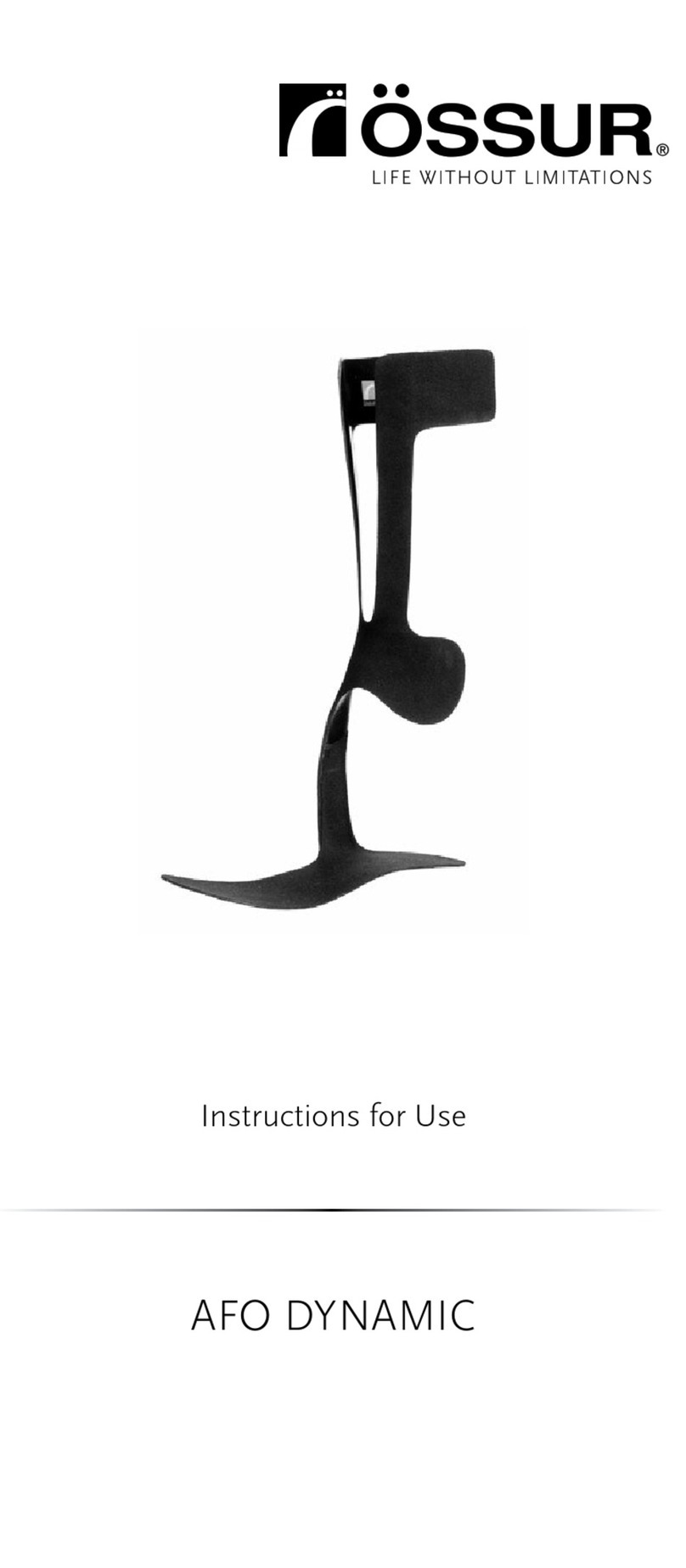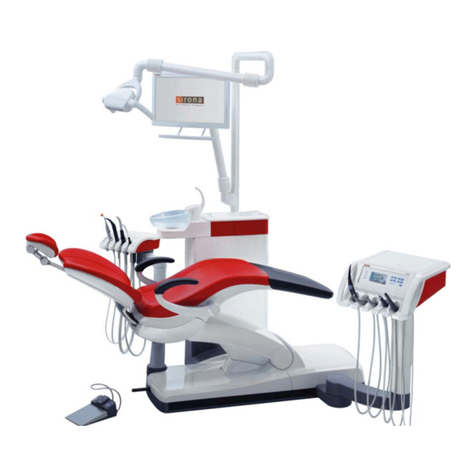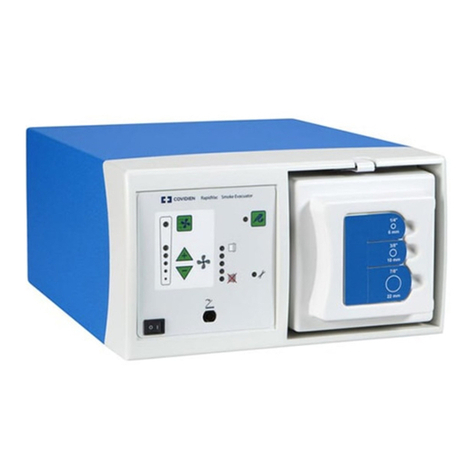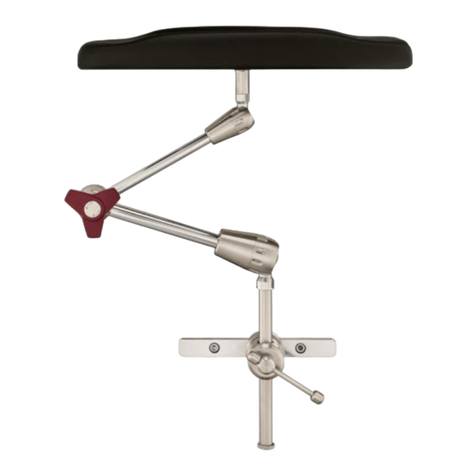SINJI Pulse Oximeter User manual

PULSE OXIMETER
BESCHRIJVING
De Sinji Pulse Oximeter is een draagbaar toestel waarmee de
zuurstofsaturatie en polsslag (hartslag) gemeten kan worden via de
vinger. Dankzij het geavanceerde DSP-algoritme zijn metingen zeer
nauwkeurig. Deze oximeter is makkelijk in gebruik en geschikt voor
consumenten en professionals.
INHOUD
1x Sinji Pulse Oximeter
1x Draaglus
1x Gebruiksaanwijzing
Wat betekent de meting?
Een normale saturatiewaarde
(SpO2) zit tussen 95-100%.
Over het algemeen is de
hartslag bij volwassenen in
rust 60-100 BPM. Raadpleeg
altijd een arts om de
gezondheidssituatie te bepalen.
De oximeter is slechts een
hulpmiddel. Wijkt uw meting
af van de referentiewaarden?
Dan adviseren wij om direct uw
(huis)arts te raadplegen, om een
diagnose vast te stellen.
TECHNISCHE SPECIFICATIES
Model: Sinji Pulse Oximeter
Weergavesysteem: OLED
Voeding: 2x AAA batterijen 1.5V
Meetbereik: Zuurstofverzadiging: 70% - 100%, pols:
30 – 254 bpm
Nauwkeurigheid: Zuurstofverzadiging: ±3%, pols ± 2BPM
Automatisch uit: na 8 seconden
Afmetingen: 5.8 x 3.6 x 3.3 cm
Gewicht: 50 g
BATTERIJEN PLAATSEN
Plaats voor gebruik twee AAA batterijen in het toestel. Open het
batterijvakje en let goed op de polariteit zoals aangegeven in het
batterijvakje. Sluit het batterijvakje na plaatsing.
DRAAGLUS PLAATSEN
Bevestig de meegeleverde draaglus door deze door het gaatje te
halen.
GEBRUIKSAANWIJZING
1. Open de vingeropening door het druk gedeelte samen te
drukken.
2. Plaats één van je vingers zo ver mogelijk in de rubberen
vingeropening.
3. Druk op de startknop om te beginnen met de meting.
4. Hou je vinger en lichaam zo rustig mogelijk tijdens de meting,
voor het beste resultaat.
5. Na korte tijd worden de polsfrequentie en gemeten
zuurstofverzadiging aangeduid op het scherm.
6. Trek je vinger uit de vingeropeningen en het apparaat gaat
automatisch uit na 8 seconden. Reinig het rubberen gedeelte na
gebruik.
Factory: Xuzhou Yongkang Electronic Science Technology Co. Ltd.
4F Building C8, 40 Jingshan Road, Economic and technological
Development Zone, 221000 Xuzhou, People’s republic of china
ec rep: Prolinx GmbH
Brehmstr. 56, 40239, Dusseldorf
Germany
0123

VEILIGHEIDTIPS
• Dit toestel mag niet in de buurt van kernspintomografie (MRT) of
computertomografen (CT) worden gebruikt.
• Gebruik de oximeter niet in de buurt van explosieve, resp.
brandbare stoffen - explosiegevaar!
• Het toestel is niet geschikt voor continue monitoring van de
zuurstofsaturatie in het bloed
• Vinger en toestel moeten schoon zijn, opdat een probleemloze
meting zou kunnen worden uitgevoerd.
• Onnauwkeurige metingen kunnen bovendien ontstaan in geval
van:
o Disfunctioneel hemoglobine of een lage hemoglobinespiegel
oGebruik van intravasculaire kleurstoffen - Helverlichte
omgeving - grotere bewegingen van hand of lichaam
o Het gebruik van elektrochirurgische interferenties en
defibrillatoren met hoge frequentie
o Veneus pulsatie-artefact
o Gelijktijdig gebruik van manchetten van bloeddrukmeters,
katheters of intravasculaire ingangen
o Patiënten met hoge bloeddruk,vaatvernauwing, bloedarmoede
of hypothermie
o Hartstilstand en shocktoestanden
o Kunstmatige vingernagels
o Doorbloedingsstoornissen
• De oximeter is slechts een bijkomend hulpmiddel bij het
beoordelen van de situatie van de patiënt.
• Elektrochirurgische instrumenten kunnen de werking van het
toestel verminderen
• De gezondheidssituatie kan maar bepaald worden wanneer een
arts nog meer klinische, resp. professionele onderzoeken uitvoert
• Bij langdurig gebruik of na gebruik bij elke patiënt, moet het
meetpunt regelmatig veranderd worden. Het meetpunt moet
om de 4 uur veranderd worden, waarbij de integriteit van de
huid en de toestand van de bloedsomloop van de patiënt moeten
worden gecontroleerd.
REINIGING
Verwijder de batterijen voordat u het toestel reinigt. Gebruik nooit
agressieve reinigingsmiddelen of harde borstels. Reinig het toestel
met een zachte doek die u lichtjes bevochtigt met isopropylalcohol.
Er mag geen vocht doordringen in het toestel. Gebruik het toestel
pas weerwanneer het helemaal droog is.
PROBLEMEN EN OPLOSSINGEN
Probleem
Zuurstofsaturatie of
polsslag
wordt niet goed
weergeven
Zuurstofsaturatie of
polsslag is instabiel
Het toestel gaat niet aan
De verlichting van het
scherm gaat plots uit
Oorzaak
1. De vinger zit niet goed
in de vingeropening.
2. De zuurstofsaturatie
van de gebruiker is te
laag en kan niet worden
gemeten.
1. Vinger zit niet ver
genoeg in het toestel.
2. De vinger of lichaam
beweegt te veel.
1. De batterijen zijn leeg.
2. De batterijen zitten niet
goed in het toestel.
3. Het toestel is
beschadigd.
1. Als er geen vinger is
gedetecteerd, schakelt
het toestel automatisch uit
na 8 seconden.
2. De batterij heeft
onvoldoende kracht
Oplossing
1. Plaats de vinger correct
in de vingeropening en
probeer het opnieuw.
2. Controleer of het
toestel goed werkt door
een meting te doen bij een
ander persoon.
1. Plaats de vinger correct
in de vingeropening en
probeer het opnieuw.
2. Probeer je lichaam stil
te houden.
1. Vervang de batterijen
2. Controleer of de
batterijen correct zijn
geplaatst
3. Neem contact op met
de klantenservice
1. Plaats de vinger in de
vingeropening en probeer
opnieuw
2. Vervang de batterijen

PULSE OXIMETER
DESCRIPTION
The Sinji Pulse Oximeter is a portable device with which the oxygen
saturation and pulse (heart rate) can be measured via the finger.
Thanks to the advanced DSP algorithm, measurements are very
accurate. This oximeter is easyto use and suitable for consumers
and professionals.
IN THE BOX
1x Sinji Pulse Oximeter
1x Cord
1x Manual
What does the
measurement mean?
A normal saturation value
(SpO2) is between 95-100%.
A value below 90% can indicate
health problems. In general,
the resting heart rate for adults
is 60-100 BPM. Consult
your physician to determine
a diagnosis if the SpO2 and
/ or heart rate measurement
deviates from the reference
values.
TECHNICAL SPECIFICATIONS
Model Sinji Pulse Oximeter
Display system OLED
Power supply 2x AAA batteries 1.5V
Measurement range Oxygen saturation: 70% - 100%,
pulse: 30 - 254 bpm
Accuracy Oxygen Saturation: ± 3%, pulse ± 2BPM
Automatically off after 8 seconds
Dimensions 5.8 x 3.6 x 3.3 cm
Weight 50 g
INSERT BATTERIES
Before use, insert two AAA batteries into the device. Open the
battery compartment and observe the polarity as indicated in
the battery compartment. Close the battery compartment after
insertion.
ATTACHING THE CORD
Attach the supplied carrying loop by putting it through the hole.
INSTRUCTIONS
1. Open the finger hole by squeezing the part marked “push”.
2. Place one ofyour fingers into the rubber finger hole.
3. Press the start button to start the measurement.
4. Keep your finger and body as still as possible during the
measurement for best results.
5. After a short while, the pulse rate and measured oxygen
saturation will be indicated on the display.
6. Remove your fingerfrom the finger holes and the device will
automatically turn off after 8 seconds. Clean the rubber part after
use.
Factory: Xuzhou Yongkang Electronic Science Technology Co. Ltd.
4F Building C8, 40 Jingshan Road, Economic and technological
Development Zone, 221000 Xuzhou, People’s republic of china
ec rep: Prolinx GmbH
Brehmstr. 56, 40239, Dusseldorf
Germany
0123

SAFETYTIPS
• This device should not be used in the vicinity of magnetic
resonance imaging (MRT) or computertomographs (CT).
• Do not use the oximeter in the vicinity of explosive, resp.
flammable materials - risk of explosion!
• The device is not suitable for continuous monitoring of oxygen
saturation in the blood
• Finger and device must be clean so that a problem-free
measurement can be taken.
• Inaccurate measurements can also arise in case of:
o Dysfunctional hemoglobin or low hemoglobin level
o Use of intravascular dyes - Bright environment - greater hand
or body movements
o Use of electrosurgical interferences and high frequency
defibrillators
o Venous pulsation artifact
o Simultaneous use of blood pressure monitor cuffs, catheters or
intravascular ports
o Patients with high blood pressure, vasoconstriction, anemia or
hypothermia
o Cardiac arrest and shock states
o Artificial fingernails
o Circulation disorders
• The oximeter is only an additional aid in assessing the patient’s
situation.
• Electrosurgical instruments can impair the performance of the
device
• The health situation can only be determined when a doctor has
more clinical, resp. conduct professional investigations
• During prolonged use or after use on each patient, the
measuring point should be changed regularly. The measurement
point should be changed every 4 hours, checking the skin
integrity and circulatory status of the patient.
CLEANING
Remove the batteries before cleaning the device. Never use
aggressive cleaning agents or hard brushes. Clean the device with
a soft cloth slightly dampened with isopropyl alcohol. Moisture must
not penetrate into the device. Do not use the device again until it is
completely dry.
PROBLEMS AND SOLUTIONS
Problem
Oxygen saturation or
pulse does not display
properly
Oxygen saturation or
pulse is unstable
The device does not
turn on
The backlight ofthe
screen suddenlyturns off
Cause
1. The finger is not
properly inserted in the
finger hole.
2. The user’s oxygen
saturation is too low and
cannot be measured.
1. Finger is not far enough
in the device.
2. The finger or body is
moving too much.
1. The batteries are empty.
2. The batteries are not
properly inserted in the
device.
3. The device is damaged.
1. If no finger is detected,
the device will turn off
automatically after 8
seconds.
2. The battery has
insufficient power.
Solution
1. Place the finger
correctly in the finger hole
and try again.
2. Verify that the device
is working properly by
taking a measurement on
another person.
1. Place the finger
correctly in the finger hole
and try again.
2. Try to keep your body
still.
1. Replace the batteries
2. Check if the batteries
are installed correctly
3. Contact customer
service
1. Place your finger in the
finger hole and try again
2. Replace the batteries

PULSE OXIMETER
BESCHREIBUNG
Das Sinji Pulsoximeter ist ein tragbares Gerät, mit dem die
Sauerstoffsättigung und der Puls (Herzfrequenz) über den Finger
gemessen werden können. Dank des fortschrittlichen DSP-
Algorithmus sind die Messungen sehr genau. Dieses Oximeter ist
einfach zu bedienen und für Verbraucher und Fachleute geeignet.
INHALT
1x Sinji Pulsoximeter
1x Trageschleife
1x Bedienungsanleitung
Was bedeutet die Messung?
Ein normaler Sättigungswert
(SpO2) liegt zwischen 95 und
100%. Ein Wert unter 90%
kann auf gesundheitliche
Probleme hinweisen. Im
Allgemeinen beträgt die
Ruheherzfrequenz bei
Erwachsenen 60-100 BPM.
Fragen Sie Ihren Arzt, um
eine Diagnose zu stellen,
wenn die SpO2- und / oder
Herzfrequenzmessung von den
Referenzwerten abweicht.
TECHNISCHE SPEZIFIKATIONEN
Modell Sinji Pulsoximeter
Anzeigesystem OLED
Stromversorgung 2x AAA-Batterien 1,5V
Messbereich Sauerstoffsättigung: 70% - 100%, Puls: 30 - 254
Schläge pro Minute
Genauigkeit Sauerstoffsättigung: ± 3%, Puls ± 2 BPM
Nach 8 Sekunden automatisch ausgeschaltet
Abmessungen 5,8 x 3,6 x 3,3 cm
Gewicht 50 g
BATTERIEN EINFÜGEN
Legen Sie vor dem Gebrauch zwei AAA-Batterien in das Gerät ein.
Öffnen Sie das Batteriefach und achten Sie auf die im Batteriefach
angegebene Polarität. Schließen Sie das Batteriefach nach dem
Einsetzen.
SETZEN SIE DIE TRAGESCHLEIFE EIN
Befestigen Sie die mitgelieferte Trageschlaufe, indem Sie sie durch
das Loch stecken.
ANLEITUNG
1. Öffnen Sie das Fingerloch, indem Sie das mit „Push“
gekennzeichnete Teil zusammendrücken.
2. Legen Sie einen Ihrer Finger so weit wie möglich in das
Gummifingerloch.
3. Drücken Sie die Starttaste, um die Messung zu starten.
4. Halten Sie Finger und Körperwährend der Messung so ruhig wie
möglich, um optimale Ergebnisse zu erzielen.
5. Nach kurzer Zeit werden die Pulsfrequenz und die gemessene
Sauerstoffsättigung auf dem Display angezeigt.
6. Ziehen Sie Ihren Finger aus den Fingerlöchern und das Gerät
schaltet sich nach 8 Sekunden automatisch aus. Reinigen Sie
das Gummiteil nach Gebrauch.
Factory: Xuzhou Yongkang Electronic Science Technology Co. Ltd.
4F Building C8, 40 Jingshan Road, Economic and technological
Development Zone, 221000 Xuzhou, People’s republic of china
ec rep: Prolinx GmbH
Brehmstr. 56, 40239, Dusseldorf
Germany
0123

SICHERHEITSTIPPS
• Dieses Gerät darf nicht in derNähe von
Magnetresonanztomographen (MRT) oder
Computertomographen (CT) verwendet werden.
• Verwenden Sie das Oximeter nicht in der Nähe von
Explosivstoffen bzw. Sprengstoffen. brennbare Materialien -
Explosionsgefahr!
• Das Gerät ist nicht zur kontinuierlichen Überwachung der
Sauerstoffsättigung im Blut geeignet
• Finger und Gerät müssen sauber sein, damit problemlos
gemessen werden kann.
• Ungenaue Messungen können auch auftreten bei:
o Dysfunktionelles Hämoglobin oderniedriger Hämoglobinspiegel
o Verwendung von intravaskulären Farbstoffen - Helle
Umgebung - größere Hand- oder Körperbewegungen
o Verwendung von elektrochirurgischen Interferenzen und
Hochfrequenzdefibrillatoren
o Venöses Pulsationsartefakt
o GleichzeitigeVerwendung von Manschetten, Kathetern oder
intravaskulären Öffnungen des Blutdruckmessgeräts
o Patienten mit hohem Blutdruck, Vasokonstriktion, Anämie oder
Unterkühlung
o Herzstillstand und Schockzustände
o Künstliche Fingernägel
o Durchblutungsstörungen
• Das Oximeter ist nureine zusätzliche Hilfe bei der Beurteilung der
Situation des Patienten.
• Elektrochirurgische Instrumente können die Leistung des Geräts
beeinträchtigen
• Die gesundheitliche Situation kann nur bestimmtwerden, wenn ein
Arzt klinischer ist. professionelle Untersuchungen durchführen
• Bei längerem Gebrauch oder nach Gebrauch bei jedem Patienten
sollte der Messpunkt regelmäßig gewechseltwerden. Der
Messpunkt sollte alle 4 Stunden gewechselt werden, um die
Hautintegrität und den Kreislaufstatus des Patienten zu überprüfen.
REINIGUNG
Entfernen Sie die Batterien, bevor Sie das Gerät reinigen. Verwenden
Sie niemals aggressive Reinigungsmittel oder harte Bürsten. Reinigen
Sie das Gerät mit einem weichen Tuch, das leicht mit Isopropylalkohol
angefeuchtet ist. Feuchtigkeit darf nicht in das Gerät eindringen.
Verwenden Sie das Gerät erstwieder,wenn es vollständigtrocken ist.
PROBLEME UND LÖSUNGEN
Problem
Sauerstoffsättigung oder
Puls wird nicht richtig
angezeigt
Sauerstoffsättigung oder
Puls ist instabil
Das Gerät lässt sich nicht
einschalten
DieHintergrundbeleuchtung
des Bildschirms erlischt
plötzlich
Ursache
1. Der Fingerist nicht richtig
in das Fingerloch eingeführt.
2. Die Sauerstoffsättigung
des Benutzers ist zu niedrig
und kann nicht gemessen
werden
1. Der Fingerist nichtweit
genug im Gerät.
2. Der Finger oder Körper
bewegt sich zu stark.
1. Die Batterien sind leer.
2. Die Batterien sind
nicht richtig in das Gerät
eingelegt.
3. Das Gerät ist beschädigt.
1. Wenn kein Fingererkannt
wird, schaltet sich das
Gerät nach 8 Sekunden
automatisch aus.
2. DerAkku ist nicht
ausreichend mit Strom
versorgt.
Lösung
1. Legen Sie den Finger
richtig in das Fingerloch und
versuchen Sie es erneut.
2. Stellen Sie sicher, dass
das Gerät ordnungsgemäß
funktioniert, indem Sie eine
Messung an einer anderen
Person durchführen.
1. Legen Sie den Finger
richtig in das Fingerloch und
versuchen Sie es erneut.
2. Versuchen Sie, Ihren
Körper ruhig zu halten.
1. Tauschen Sie die
Batterien aus
2. Überprüfen Sie, ob die
Batterien richtig eingelegt
sind
3. Wenden Sie sich an den
Kundendienst
1. Place your finger in the
finger hole and try again
2. Replace the batteries

PULSE OXIMETER
LA DESCRIPTION
L’oxymètre de pouls Sinji est un appareil portable avec lequel la
saturation en oxygène et le pouls (fréquence cardiaque) peuvent
être mesurés au doigt. Grâce à l’algorithme DSP avancé, les
mesures sont très précises. Cet oxymètre est simple d’utilisation et
convient aux consommateurs et aux professionnels.
DANS LE PACKAGE
1x oxymètre de pouls Sinji
1x boucle de transport
1x manuel d’instructions
Que signifie la mesure?
Une valeur de saturation
normale (SpO2) est comprise
entre 95 et 100%. Une valeur
inférieure à 90% peut indiquer
des problèmes de santé. En
général, la fréquence cardiaque
au repos chez les adultes est
de 60 à 100 BPM. Consultez
votre médecin pour établir
un diagnostic si la mesure de
SpO2 et / ou de fréquence
cardiaque s’écarte des valeurs
de référence.
SPÉCIFICATIONS TECHNIQUES
modèle Oxymètre de pouls Sinji
Système d’affichage OLED
Alimentation 2x piles AAA 1.5V
Plage de mesure Saturation en oxygène: 70% - 100%, impulsion:
30 - 254 bpm
précision Saturation en oxygène: ± 3%, impulsion ±
2BPM
Arrêt automatique après 8 secondes
Dimensions 5,8 x 3,6 x 3,3 cm
Poids 50 g
INSÉRER LES PILES
Insérez deux piles AAA dans l’appareil avant utilisation. Ouvrez le
compartiment à piles et observez la polarité comme indiqué dans
le compartiment à piles. Fermez le compartiment à piles après
l’insertion.
INSÉRER LA BOUCLE DETRANSPORT
Fixez la boucle de transport fournie en la passant àtravers le trou.
MANUEL D’UTILISATION
1. Ouvrez letrou pour les doigts en pressant la partie marquée «push».
2. Placez l’un de vos doigts dans l’orifice en caoutchouc le plus loin
possible.
3. Appuyez sur le bouton de démarrage pour démarrer la mesure.
4. Gardezvotre doigt etvotre corps aussi immobiles que possible
pendant la mesure pour de meilleurs résultats.
5. Après quelques instants, lafréquence du pouls et lasaturation en
oxygène mesurée seront indiquées surl’écran.
6. Retirez votre doigt des trous pour les doigts et l’appareil s’éteint
automatiquement après 8 secondes. Nettoyez la partie en
caoutchouc après utilisation.
Factory: Xuzhou Yongkang Electronic Science Technology Co. Ltd.
4F Building C8, 40 Jingshan Road, Economic and technological
Development Zone, 221000 Xuzhou, People’s republic of china
ec rep: Prolinx GmbH
Brehmstr. 56, 40239, Dusseldorf
Germany
0123

CONSEILS DE SÉCURITÉ
• Cet appareil ne doit pas être utilisé à proximité d’imagerie par
résonance magnétique (MRT) ou de tomographie par ordinateur
(CT).
• N’utilisez pas l’oxymètre à proximité d’explosifs, resp. matières
inflammables - risque d’explosion!
• L’appareil n’est pas adapté à la surveillance continue de la
saturation en oxygène dans le sang
• Les doigts et l’appareil doivent être propres pour permettre une
mesure sans problème.
• Des mesures inexactes peuvent également survenir en cas de:
o Hémoglobine dysfonctionnelle ou faible taux d’hémoglobine
o Utilisation de colorants intravasculaires - Environnement
lumineux - mouvements plus importants de la main ou du corps
o Utilisation d’interférences électrochirurgicales et de
défibrillateurs haute fréquence
o Artefact de pulsation veineuse
o Utilisation simultanée de brassards, de cathéters ou de ports
intravasculaires pour tensiomètres
o Patients souffrant d’hypertension artérielle, de
vasoconstriction, d’anémie ou d’hypothermie
o Arrêt cardiaque et états de choc
o Ongles artificiels
o Troubles de la circulation
• L’oxymètre n’est qu’une aide supplémentaire pour évaluer la
situation du patient.
• Les instruments électrochirurgicaux peuvent altérer les
performances de l’appareil
• La situation sanitaire ne peut être déterminée que lorsqu’un
médecin a plus de clinique, resp. mener des enquêtes
professionnelles
• Lors d’une utilisation prolongée ou après une utilisation sur
chaque patient, le point de mesure doit être changé
régulièrement. Le point de mesure doit être changé toutes les
4 heures, en vérifiant l’intégrité de la peau et l’état circulatoire du
patient.
NETTOYAGE
Retirez les piles avant de nettoyer l’appareil. N’utilisez jamais de
produits de nettoyage agressifs ou de brosses dures. Nettoyez
l’appareil avec un chiffon doux légèrement imbibé d’alcool
isopropylique. L’humidité ne doit pas pénétrer dans l’appareil.
N’utilisez plus l’appareil tant qu’il n’est pas complètement sec.
PROBLÈMES ET SOLUTIONS
Problème
Saturation ou impulsion en
oxygène ne s’affiche pas
correctement
La saturation ou le pouls en
oxygène est instable
L’appareil ne s’allume pas
Le rétroéclairage de l’écran
s’éteint soudainement
Cause
1. Le doigt n’est pas
correctement inséré dans le
trou pour le doigt.
2. La saturation en oxygène
de l’utilisateur est trop
faible et ne peut pas être
mesurée.
1. Le doigt n’est pas assez
loin dans l’appareil.
2. Le doigt ou le corps
bouge trop.
1. Les piles sont vides.
2. Les piles ne sont pas
correctement insérées
dans l’appareil.
3. L’appareil est
endommagé.
1. Si aucun doigt n’est
détecté, l’appareil s’éteint
automatiquement après 8
secondes.
2. La batterie est
insuffisante
Solution
1. Placez correctement le
doigt dans le trou pourle
doigt et réessayez.
2. Vérifiez que l’appareil
fonctionne correctement
en prenant une mesure sur
une autre personne.
1. Placez correctement le
doigt dans le trou pourle
doigt et réessayez.
2. Essayez de garder votre
corps immobile.
1. Remplacez les piles
2. Vérifiez si les piles sont
correctement installées
3. Contactez le service
client
1. Placez votre doigt dans
le trou pourle doigt et
réessayez
2. Remplacez les piles

PULSE OXIMETER
DESCRIPCIÓN
El pulsioxímetro Sinji es un dispositivo portátil con el que se puede
medir la saturación de oxígeno y el pulso (frecuencia cardíaca)
con el dedo. Gracias al avanzado algoritmo DSP, las mediciones
son muy precisas. Este oxímetro es fácil de usar y adecuado para
consumidores y profesionales.
EN EL PAQUETA
1x oxímetro de pulso Sinji
1x lazo de transporte
1x manual de instrucciones
¿Qué significa la medida?
Un valorde saturación normal
(SpO2) está entre 95-100%.
Un valor por debajo del 90%
puede indicar problemas de
salud. En general, la frecuencia
cardíaca en reposo en adultos
es de 60-100 BPM. Consulte
a su médico para determinar un
diagnóstico si la medición de
SpO2 y / o frecuencia cardíaca
se desvía de los valores de
referencia.
ESPECIFICACIONES TÉCNICAS
modelo Oxímetro de pulso Sinji
Sistema de visualización OLED
Fuente de alimentación 2x pilas AAA 1.5V
Rango de medición Saturación de oxígeno: 70% - 100%, pulso:
30 - 254 lpm
Precisión Saturación de oxígeno: ± 3%, pulso ± 2 BPM
Apagado automáticamente después de 8 segundos
Dimensiones 5,8 x 3,6 x 3,3 cm
Peso 50 g
INSERTE LAS BATERÍAS
Antes de usarlo, inserte dos baterías AAA en el dispositivo. Abra el
compartimiento de la batería y observe la polaridad como se indica
en el compartimiento de la batería. Cierre el compartimento de la
batería después de la inserción.
INSERTAR EL LAZO DE TRANSPORTE
Coloque el lazo de transporte suministrado pasándolo por el orificio.
INSTRUCCIONES
1. Abra el orificio del dedo apretando la parte marcada como
“empujar”.
2. Coloque uno de sus dedos en el orificio de goma para los dedos
tanto como sea posible.
3. Presione el botón de inicio para iniciar la medición.
4. Mantenga el dedo y el cuerpo lo más quietos posible durante la
medición para obtener mejores resultados.
5. Después de un rato, la frecuencia del pulso y la saturación de
oxígeno medida se indicarán en la pantalla.
6. Retire el dedo de los orificios para los dedos y el dispositivo se
apagará automáticamente después de 8 segundos. Limpiar la
parte de goma después de su uso.
Factory: Xuzhou Yongkang Electronic Science Technology Co. Ltd.
4F Building C8, 40 Jingshan Road, Economic and technological
Development Zone, 221000 Xuzhou, People’s republic of china
ec rep: Prolinx GmbH
Brehmstr. 56, 40239, Dusseldorf
Germany
0123

CONSEJOS DE SEGURIDAD
• Este dispositivo no debe utilizarse cerca de imágenes por
resonancia magnética (MRT) o tomógrafos computarizados (TC).
• No utilice el oxímetro cerca de explosivos, resp. materiales
inflamables - ¡riesgo de explosión!
• El dispositivo no es adecuado para la monitorización continua de
la saturación de oxígeno en la sangre.
• El dedo y el dispositivo deben estar limpios para poder realizar
una medición sin problemas.
• También pueden surgir mediciones inexactas en caso de:
o Hemoglobina disfuncional o nivel bajo de hemoglobina
o Uso de tintes intravasculares - Ambiente brillante - mayores
movimientos de la mano o del cuerpo
o Uso de interferencias electroquirúrgicas y desfibriladores de
alta frecuencia
o Artefacto de pulsación venosa
o Uso simultáneo de manguitos, catéteres o puertos
intravasculares del monitor de presión arterial
o Pacientes con hipertensión arterial, vasoconstricción, anemia o
hipotermia
o Estados de paro cardíaco y shock
o Uñas artificiales
o Trastornos de la circulación
• El oxímetro es solo una ayuda adicional para evaluar la situación
del paciente.
• Los instrumentos electroquirúrgicos pueden afectar el
rendimiento del dispositivo
• La situación de salud solo se puede determinar cuando
un médico tiene más clínica, resp. realizar investigaciones
profesionales
• Durante el uso prolongado o después del uso en cada paciente,
el punto de medición debe cambiarse regularmente. El punto de
medición debe cambiarse cada 4 horas, comprobando la
integridad de la piel y el estado circulatorio del paciente.
LIMPIEZA
Retire las baterías antes de limpiar el dispositivo. No utilice
nunca agentes de limpieza agresivos o cepillos duros. Limpie el
dispositivo con un paño suave ligeramente humedecido con alcohol
isopropílico. La humedad no debe penetrar en el dispositivo. No
vuelva a utilizar el dispositivo hasta que esté completamente seco.
PROBLEMAS Y SOLUCIONES
Problema
Saturación de oxígeno
o pulso no se muestra
correctamente
La saturación de oxígeno
o el pulso son inestables
El dispositivo no se
enciende
La luz de fondo de
la pantalla se apaga
repentinamente
Causa
1. El dedo no está
insertado correctamente
en el orificio del dedo.
2. La saturación de
oxígeno del usuario es
demasiado baja yno se
puede medir.
1. El dedo no está lo
suficientemente lejos en
el dispositivo.
2. El dedo o el cuerpo se
mueven demasiado.
1. Las pilas están vacías.
2. Las baterías no están
insertadas correctamente
en el dispositivo.
3. El dispositivo está
dañado.
1. Si no se detecta ningún
dedo, el dispositivo se
apagará automáticamente
después de 8 segundos.
2. La batería no tiene
carga suficiente.
Solución
1. Coloque el dedo
correctamente en el
orificio del dedo yvuelva a
intentarlo.
2. Verifique que
el dispositivo
esté funcionando
correctamente tomando
una medida en otra
persona.
1. Coloque el dedo
correctamente en el
orificio del dedo yvuelva a
intentarlo.
2. Trate de mantener su
cuerpo quieto.
1. Reemplace las baterías
2. Verifique si las
baterías están instaladas
correctamente
3. Póngase en contacto
con el servicio de atención
al cliente
1. Coloque el dedo en el
orificio del dedo yvuelva a
intentarlo
2. Reemplace las baterías

PULSE OXIMETER
DESCRIZIONE
Il Sinji Pulse Oximeter è un dispositivo portatile con il quale è
possibile misurare la saturazione di ossigeno e il polso (frequenza
cardiaca) tramite il dito. Grazie all’avanzato algoritmo DSP, le
misurazioni sono molto accurate. Questo ossimetro è facile da usare
e adatto a consumatori e professionisti.
NELLA CONFEZIONE
1x pulsossimetro Sinji
1x anello per il trasporto
1x manuale di istruzioni
Cosa significa la
misurazione?
Un valore di saturazione
normale (SpO2) è compreso tra
95 e 100%. Un valore inferiore
al 90% può indicare problemi di
salute. In generale, la frequenza
cardiaca a riposo negli adulti è
di 60-100 BPM. Consultare il
proprio medico per determinare
una diagnosi se la misurazione
della SpO2 e / o della frequenza
cardiaca devia dai valori di
riferimento.
SPECIFICHE TECNICHE
Modello Sinji Pulse Oximeter
Sistema di visualizzazione OLED
Alimentazione 2x batterie AAA 1.5V
Intervallo di misurazione Saturazione dell’ossigeno: 70% - 100%,
pulsazioni: 30 - 254 bpm
Precisione saturazione dell’ossigeno: ± 3%, pulsazioni ± 2 BPM
Spegnimento automatico dopo 8 secondi
Dimensioni 5,8 x 3,6 x 3,3 cm
Peso 50 g
INSERIRE BATTERIE
Prima dell’uso, inserire due batterie AAA nel dispositivo. Aprire il
vano batteria e osservare la polarità come indicato nel vano batteria.
Chiudere il vano batteria dopo l’inserimento.
INSERIRE LOOP DI TRASPORTO
Attaccare il passante per il trasporto in dotazione facendolo passare
attraverso il foro.
ISTRUZIONI
1. Aprire il foro per le dita premendo la parte contrassegnata con
“push”.
2. Posizionare un dito il più possibile nel foro in gomma.
3. Premere il pulsante di avvio per avviare la misurazione.
4. Tenere il dito e il corpo il più fermi possibile durante la
misurazione per ottenere i migliori risultati.
5. Dopo qualche istante, la frequenza del polso e la saturazione di
ossigeno misurata verranno indicate sul display.
6. Estrarre il dito dai fori e il dispositivo si spegnerà
automaticamente dopo 8 secondi. Pulire la parte in gomma dopo
l’uso.
Factory: Xuzhou Yongkang Electronic Science Technology Co. Ltd.
4F Building C8, 40 Jingshan Road, Economic and technological
Development Zone, 221000 Xuzhou, People’s republic of china
ec rep: Prolinx GmbH
Brehmstr. 56, 40239, Dusseldorf
Germany
0123

SUGGERIMENTI PER LA SICUREZZA
• Questo dispositivo non deve essere utilizzato in prossimità di
risonanza magnetica per immagini (MRT) o tomografi
computerizzati (TC).
• Non utilizzare l’ossimetro in prossimità di esplosivi, risp. materiali
infiammabili - rischio di esplosione!
• Il dispositivo non è adatto per il monitoraggio continuo della
saturazione di ossigeno nel sangue
• Il dito e il dispositivo devono essere puliti in modo da poter
eseguire una misurazione senza problemi.
• Misurazioni imprecise possono anche verificarsi in caso di:
o Emoglobina disfunzionale o basso livello di emoglobina
o Uso di coloranti intravascolari - Ambiente luminoso - maggiori
movimenti della mano o del corpo
o Uso di interferenze elettrochirurgiche e defibrillatori ad alta
frequenza
o Artefatto di pulsazione venosa
o Uso simultaneo di bracciali, cateteri o porte intravascolari per
monitor della pressione sanguigna
o Pazienti con pressione sanguigna alta, vasocostrizione, anemia
ipotermia
o Arresto cardiaco e stati di shock
o unghie artificiali
o Disturbi della circolazione
• L’ossimetro è solo un ausilio aggiuntivo nella valutazione della
situazione del paziente.
• Gli strumenti elettrochirurgici possono compromettere le
prestazioni del dispositivo
• La situazione sanitaria può essere determinata solo quando un
medico ha più cliniche, risp. condurre indagini professionali
• Durante un uso prolungato o dopo l’uso su ciascun paziente, il
punto di misurazione deve essere cambiato regolarmente. Il
punto di misurazione deve essere cambiato ogni 4 ore,
controllando l’integrità della pelle e lo stato circolatorio del
paziente.
PULIZIA
Rimuovere le batterie prima di pulire il dispositivo. Non utilizzare
mai detergenti aggressivi o spazzole dure. Pulire il dispositivo con
un panno morbido leggermente inumidito con alcool isopropilico.
L’umidità non deve penetrare nel dispositivo. Non utilizzare
nuovamente il dispositivo finché non è completamente asciutto.
PROBLEMI E SOLUZIONI
Problema
Saturazione o pulsazioni
di ossigeno non viene
visualizzato
La saturazione
dell’ossigeno o il polso è
instabile
Il dispositivo non si
accende
La retroilluminazione
dello schermo si spegne
improvvisamente
Causa
1. Il dito non è posizionato
correttamente nel foro
del dito.
2. La saturazione di
ossigeno dell’utente è
troppo bassa e non può
essere misurata.
1. Il dito non è abbastanza
lontano nel dispositivo.
2. Il dito o il corpo si
muove troppo.
1. Le batterie sono
scariche.
2. Le batterie non sono
inserite correttamente nel
dispositivo.
3. Il dispositivo è
danneggiato.
1. Se non viene
rilevato alcun dito, il
dispositivo si spegnerà
automaticamente dopo 8
secondi.
2. La batteria ha una
potenza insufficiente
Soluzione
1. Posizionare il dito
correttamente nel foro del
dito e riprovare.
2. Verificare che il
dispositivo funzioni
correttamente effettuando
una misurazione su
un’altra persona.
1. Posizionare il dito
correttamente nel foro del
dito e riprovare.
2. Cerca di mantenere il
corpo fermo.
1. Sostituire le batterie
2. Verificare che le
batterie siano installate
correttamente
3. Contattare il servizio
clienti
1. Posizionare il dito nel
foro e riprovare
2. Sostituire le batterie

PULSE OXIMETER
OPIS
Pulsoksymetr Sinji to przenośne urządzenie, za pomocą którego
można mierzyć nasycenie tlenem i tętno (tętno) za pomocą palca.
Dzięki zaawansowanemu algorytmowi DSP pomiary są bardzo
dokładne. Ten pulsoksymetr jest łatwyw użyciu i odpowiedni dla
konsumentów i profesjonalistów.
W PACZCE
1x Pulsoksymetr Sinji
1x pętla do noszenia
1x instrukcja obsługi
Co oznacza pomiar?
Normalna wartość nasycenia
(SpO2) wynosi 95–100%.
Wartość poniżej 90% może
wskazywać na problemy
zdrowotne. Ogólnie tętno
spoczynkowe u dorosłych
wynosi 60–100 uderzeń
na minutę. Skonsultuj się z
lekarzem w celu ustalenia
diagnozy, jeśli pomiar SpO2 i /
lub tętna odbiega od wartości
odniesienia.
SPECYFIKACJATECHNICZNA
Model Pulsoksymetr Sinji
System wyświetlania OLED
Zasilanie 2x baterie AAA 1,5V
Zakres pomiarowy Nasycenie tlenem: 70% - 100%, puls: 30 - 254
uderzeń / min
Dokładność nasycenia tlenem: ± 3%, puls ± 2 BPM
Automatyczne wyłączanie po 8 sekundach
Wymiary 5,8 x 3,6 x 3,3 cm
Waga 50 g
WŁÓŻ BATERIE
Przed użyciem włóż do urządzenia dwie baterieAAA. Otwórz
komorę baterii i przestrzegaj biegunowości wskazanej w komorze
baterii. Po włożeniu zamknij komorę baterii.
ŁÓŻ PĘTLE NOSZĄCE
Zamocuj dostarczoną pętlę do przenoszenia, przeciągając ją przez
otwór.
INSTRUKCJE
1. Otwórz otwór na palec, ściskając część oznaczoną „push”.
2. Umieść jeden z palcóww gumowym otworze tak głęboko, jak to
możliwe.
3. Naciśnij przycisk start, aby rozpocząć pomiar.
4. Aby uzyskać najlepsze wyniki, podczas pomiaru palec i ciało
należy trzymać możliwie jak najbardziej nieruchomo.
5. Po krótkiej chwili na wyświetlaczu pojawi się częstość tętna i
zmierzone nasycenie tlenem.
6. Zdejmij palec z otworów na palce, a urządzenie wyłączy się
automatycznie po 8 sekundach. Oczyść gumową część po
użyciu.
Factory: Xuzhou Yongkang Electronic Science Technology Co. Ltd.
4F Building C8, 40 Jingshan Road, Economic and technological
Development Zone, 221000 Xuzhou, People’s republic of china
ec rep: Prolinx GmbH
Brehmstr. 56, 40239, Dusseldorf
Germany
0123

WSKAZÓWKI BEZPIECZEŃSTWA
• Urządzenie nie powinno być używane w pobliżu obrazowania
metodą rezonansu magnetycznego (MRT) lub tomografów
komputerowych (CT).
• Nie używaj pulsoksymetru w pobliżu materiałów wybuchowych.
materiały palne - niebezpieczeństwo wybuchu!
• Urządzenie nie nadaje się do ciągłego monitorowania saturacji
krwi tlenem
• Palec i urządzenie muszą być czyste, aby można było dokonać
bezproblemowego pomiaru.
• Niedokładne pomiary mogą również wystąpić w przypadku:
o Dysfunkcjonalna hemoglobina lub niski poziom hemoglobiny
o Stosowanie barwników wewnątrznaczyniowych - Jasne
otoczenie - większe ruchy dłoni lub ciała
o Stosowanie zakłóceń elektrochirurgicznych i defibrylatorów o
wysokiej częstotliwości
o Artefakt pulsacji żylnej
o Jednoczesne stosowanie mankietów, cewników lub portów
wewnątrznaczyniowych do ciśnieniomierzy
o Pacjenci z wysokim ciśnieniem krwi, skurczem naczyń,
niedokrwistością lub hipotermią
o Zatrzymanie krążenia i stany wstrząsu
o Sztuczne paznokcie
o Zaburzenia krążenia
• Pulsoksymetr stanowi jedynie dodatkową pomoc w ocenie
sytuacji pacjenta.
• Narzędzia elektrochirurgiczne mogą osłabić działanie urządzenia
• Sytuację zdrowotną można określić tylko wtedy, gdy lekarz
ma bardziej kliniczny charakter, tj. prowadzić profesjonalne
dochodzenia
• Podczas długotrwałego użytkowania lub po użyciu u każdego
pacjenta punkt pomiarowy należy regularnie zmieniać. Punkt
pomiarowy należy zmieniać co 4 godziny, sprawdzając
integralność skóry i stan krążenia pacjenta.
CZYSZCZENIE
Wyjmij baterie przed czyszczeniem urządzenia. Nigdy nie używaj
agresywnych środków czyszczących ani twardych szczotek.
Urządzenie czyść miękką szmatką lekko zwilżoną alkoholem
izopropylowym. Wilgoć nie może dostać się do urządzenia. Nie
używaj ponownie urządzenia, dopóki nie będzie całkowicie suche.
PROBLEMY I ROZWIĄZANIA
Problem
Nasycenie tlenem lub puls
nie wyświetla się
prawidłowo
Nasycenie tlenem lub puls
są niestabilne
Urządzenie nie włącza się
Podświetlenie ekranu
nagle się wyłącza
Przyczyna
1. Palec nie jest
prawidłowo umieszczony
w otworze na palec.
2. Nasycenie tlenem
użytkownika jest zbyt
niskie i nie można go
zmierzyć.
1. Palec nie jest
wystarczająco głęboko w
urządzeniu.
2. Palec lub ciało zbyt
mocno się porusza.
1. Baterie są wyczerpane.
2. Baterie nie są
prawidłowo włożone do
urządzenia.
3. Urządzenie jest
uszkodzone.
1. Jeżeli nie zostanie
wykryty żaden palec,
urządzenie wyłączy się
automatycznie po 8
sekundach.
Rozwiązanie
1. Umieść palec
prawidłowo w otworze na
palec i spróbuj ponownie.
2. Sprawdź, czy
urządzenie działa
prawidłowo, wykonując
pomiar na innej osobie.
1. Umieść palec
prawidłowo w otworze na
palec i spróbuj ponownie.
2. Staraj się nie ruszać
swoim ciałem.
1. Wymień baterie
2. Sprawdź, czy baterie są
prawidłowo zainstalowane
3. Skontaktuj się z obsługą
klienta
2. Bateria ma
niewystarczającą moc
1. Umieść palec w
otworze na palec i spróbuj
ponownie
2. Wymień baterie
Table of contents
Languages:
